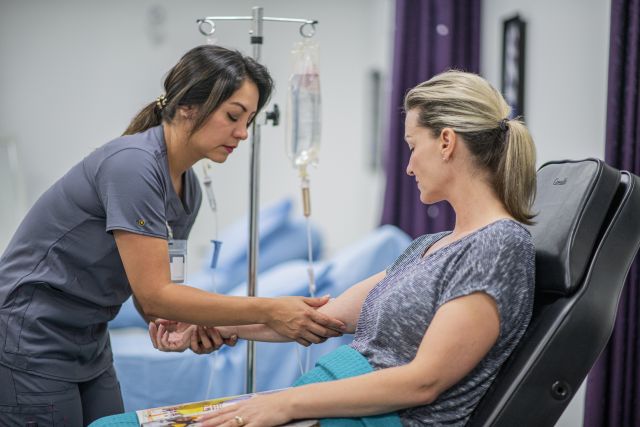Updated on April 22, 2024.
About 60 percent of women and 12 percent of men will get at least one urinary tract infection (UTI) during their lifetimes. These common infections, which occur when certain types of harmful bacteria creep into the urinary tract, are responsible for more than eight million visits to healthcare providers (HCPs) in the United States each year.
For otherwise healthy people, a UTI can usually be wiped out with a three-day course of antibiotics. But an increasing number of these infections are becoming drug-resistant, meaning they can’t be cured with the usual antibiotics.
UTIs can trigger a range of uncomfortable symptoms, including pain or burning while urinating and cloudy, bloody, or smelly pee, as well as the frequent and often urgent need to urinate. But even more concerning is that if left untreated, UTIs can move up from the urethra (the tube you use to urinate) and your bladder to your kidneys. That can lead to more serious complications, such as sepsis—a life-threatening response to infection.
What is the main culprit behind UTIs?
The bacterial species known as Escherichia coli (E. coli) is to blame for 80 to 90 percent of UTIs, according to the National Kidney Foundation.
These bacteria normally live in your gut and most strains aren’t harmful. But if they stray outside the gastrointestinal (GI) tract, some types can cause infection. UTIs, for example, can result when bacteria from the bowel enter the urinary tract. And simple physiology helps explain why these infections more often affect people with female anatomy: they have a shorter urethra than do people with male anatomy, so bacteria from the anus don’t have far to travel to get to the urinary tract.
There is also some evidence that E. coli found in fresh poultry and meat products—including chicken, turkey, and pork—can cause UTIs in people. A 2018 study published in the American Society for Microbiology's journal, mBio, found that one type of E. coli, known as E. coli ST131, was not only one of the most common strains found in 2,460 meat samples but was also the most common strain identified in 1,735 urine and blood samples collected from people with UTIs.
It’s unclear how the bacteria may spread from poultry or meat to cause infection outside of the gut. Like other foodborne illnesses, eating undercooked poultry or improperly handling raw meat may be involved.
A growing threat
In years past, drug-resistant UTIs were more likely to occur among hospitalized patients. Now, research shows that an increasing number of otherwise healthy people are developing these tough-to-treat infections.
An analysis of 1,045 urinary cultures collected from people with UTIs who visited an ER in northern California between August 2016 and July 2017 found that nearly 6 percent of these infections were caused by drug-resistant bacteria. The study, published in October 2018 in Annals of Emergency Medicine, noted that many of those treated in the ER had not been hospitalized, nor did they have other clear healthcare-linked risk factors for a resistant infection.
A July 2018 review of 25 studies involving more than 31,000 patients identified certain risk factors for multidrug-resistant UTIs. These included previous hospitalization, being a nursing home resident, and having a urinary catheter. Published in Saudi Pharmaceutical Journal, the research also noted that those who had previously taken antibiotics were also at higher risk.
Misuse of antibiotics
Before penicillin became widely available in the 1940s, more people died of bacterial infections than from non-contagious health issues, such as heart disease and cancer. Since then, the overuse or misuse of antibiotics (such as not taking them as prescribed, skipping doses, or not completing the entire course of treatment) has allowed some bacteria to adapt and develop resistance to existing drugs.
The rise in drug-resistant bacteria could increase the risk for complications associated with routine surgeries, injuries, and common infections, including UTIs.
Each year in the United States, some 2.8 million people develop infections caused by drug-resistant bacteria. These so-called superbugs now claim at least 35,000 lives annually, the Centers for Disease Control and Prevention reports.
Managing drug-resistant infections
A UTI that doesn’t clear up after a short course of antibiotics and some lifestyle adjustments may be treated with a longer course of drugs.
In more severe cases, antibiotics may be given through an IV before patients finish treatment with oral antibiotics at home.
When all other treatments are ineffective or not an option, some patients with drug-resistant UTIs may be candidates for Recarbrio, an antibacterial therapy comprising two existing drugs—imipenem and cilastatin—plus a newer drug called relebactam. The U.S. Food and Drug Administration approved Recarbrio in July 2019 for adults who have drug-resistant urinary tract infections or certain infections in the abdomen and have limited or no other treatment options.
Like all medications and other antibiotics, Recarbrio may cause unwanted side effects. The three-drug injection may cause nausea, diarrhea, headache, fever and increased liver enzymes, which may be a sign of inflammation or damage to the liver.
Despite this development, the fact is that bacteria will continue to adapt to the antibiotics that HCPs use to try to kill them. Meanwhile, these germs have been developing drug resistance more quickly than scientists have been able to develop new treatment options.
How to protect yourself
As the saying goes, the best medicine is prevention. You can help avoid UTIs and recurrent infections by making some adjustment to your routine and personal hygiene habits. Consider the following:
- Urinate after having sex.
- Drink plenty of water to avoid dehydration.
- Urinate regularly and avoid holding in urine.
- Take showers instead of baths.
- Avoid douches as well as using sprays or powders around the genitals.
- Wipe front to back.
- If you are prone to UTIs and are using birth control, check in with your HCP. Spermicidal foam and diaphragms may increase the risk for these infections.






